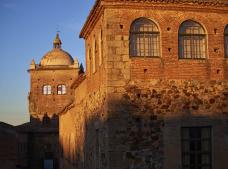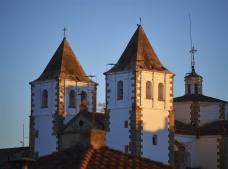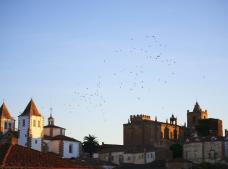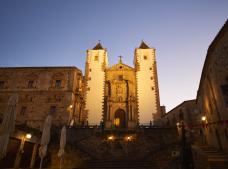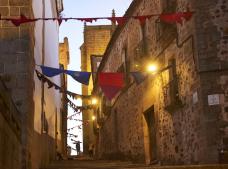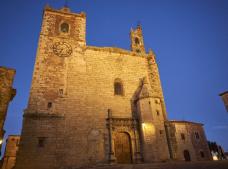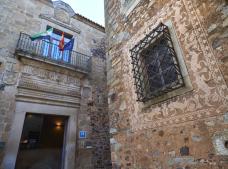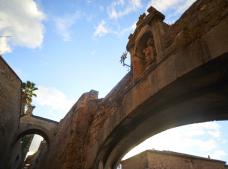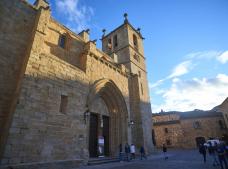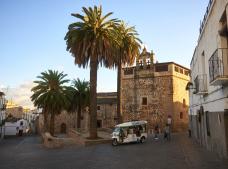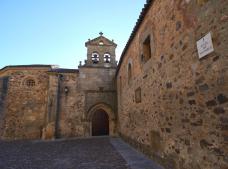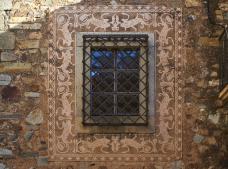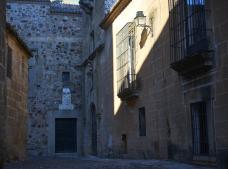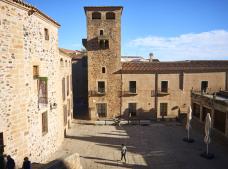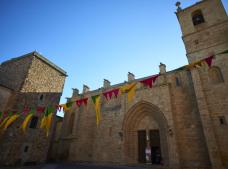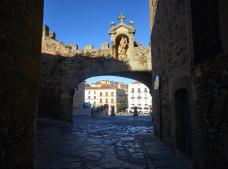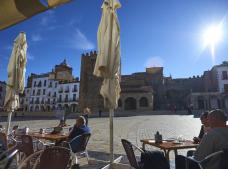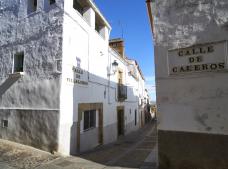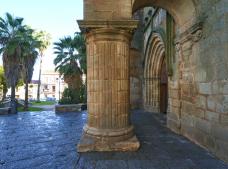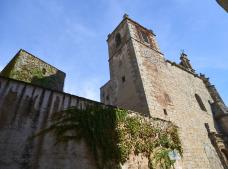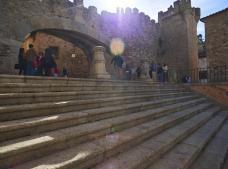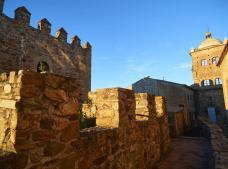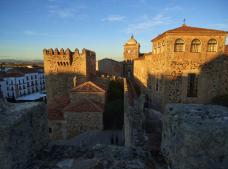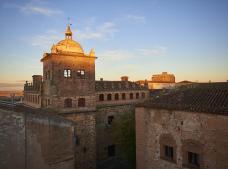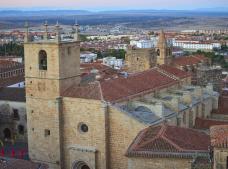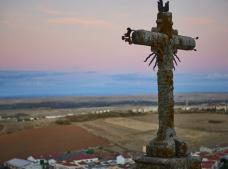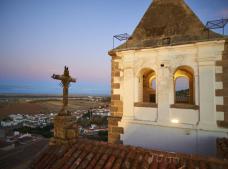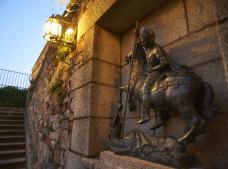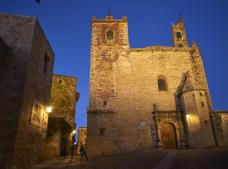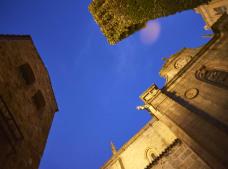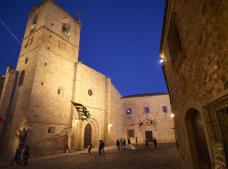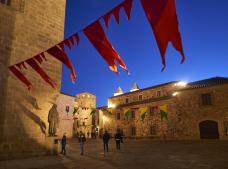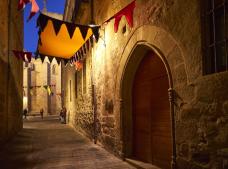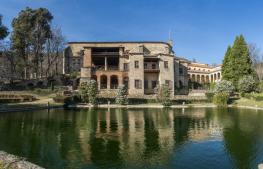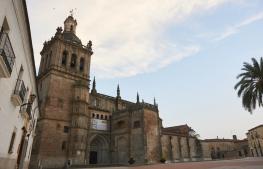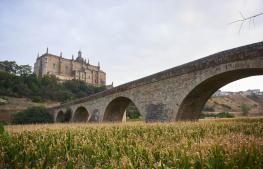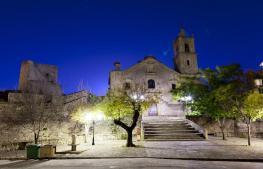Monumental city of Cáceres
World Heritage
The topography plays an important role in the urban development of Cáceres, as the city stands on uneven ground, between the Sierra de la Mosca mountains and La Sierrilla, on ground with hardened quartzites and an abundance of granite. This land provides plentiful building materials, which the Romans used to erect a 68,000-square-metre wall and which the local nobility used centuries later to build their mansions, mainly using granite, slate and quartzite. Quartzite played a very important role, because it allows water to filter through, allowing for the construction of wells and cisterns in buildings.
Remnants of the Roman period remain in ruins of the base of the wall and one of its gates, known as Christ’s Arch.
Cáceres came back to life with the arrival of the Almohads. They rebuilt the wall, destroyed during the clashes with the barbarian populations, using adobe.
The Almohad legacy is visible in the cistern they used to collect water, found today in the basement of Las Veletas Palace, which is also now one of the province’s main museums.
Fortified homes began to be built within the city walls starting in 1229, following the reconquest of the city from the Moors by Alfonso IX’s troops and the subsequent repopulation with people from the Kingdoms of León, Asturias and Galicia, who took control of the land. These buildings lost their defensive quality by the Renaissance period, a safer time when they were embellished and given a more palatial look, with more openings and courtyards.
The two districts within the walls sprang up around the parishes of Santa María and San Mateo, and they developed an urban layout characterised by narrow, winding irregular streets, generally featuring a steep slope, where the various palaces and noble homes were built. The Jewish Quarter was found along the eastern side of the wall, becoming known as ‘Barrio de San Antonio’ after the expulsion of the Jews in 1492.
The natural population growth led to the city expanding beyond its walls. A new congregation grew from the 14th century, called Santiago after the parish of the same name, forming another quarter that would connect with the wall. Congregations were groups of local residents, with legal status, established in a specific area of city and brought together by common social, religious and economic interests. Public life and representation took place around these entities.
The neighbourhood of the Santiago congregation is home to various stately buildings: the Palace of the Duke of Abrantes, Roco Godoy Palace and a public building, the Hospital of La Piedad, which was later turned into the palace of the Royal Court of Extremadura. Another congregation outside the city walls was San Juan de los Ovejeros.
The city’s increased growth and expansion, together with the creation of these congregations, led to the Plazuela de Santa María square losing prominence as the centre of commercial life, as well as the appearance, from the 15th century, of a new main square, the Plaza Mayor, a large, somewhat irregular rectangle with a slight incline, surrounded by houses whose first floors lie on arcades covered by groin vaults, where the various guilds and professions of Cáceres, as well as the town hall, used to be located. The Plaza Mayor was the perfect place for holding fairs, markets, parades, etc.
From that point, the New Gate (known as the Star Arch from the 18th century) became the point of connection between the city inside and outside the walls, turning into the main entrance within the wall.
Significant alterations took place in some of the city’s private buildings in the 18th and 19th centuries, while the city continued to grow into a new area in the 19th century, from the Church of San Juan up to the present-day Paseo de Cánovas.
Cáceres was declared a National Monument in 1949, the third monumental site in Europe and a UNESCO World Heritage City in 1986.
Walking around Cáceres is a journey of discovery in itself, although the city offers other interesting suggestions for learning about its history in a fun way. Thanks to dramatised tours, you can discover the mysteries and legends of the city. You can also find out about the city’s history and monuments on the tours organised by the numerous official guides.
Weather
Cáceres
14Dec

8 ºC
14 ºC
15Dec

7 ºC
13 ºC
16Dec

8 ºC
12 ºC
17Dec

5 ºC
14 ºC
18Dec

5 ºC
14 ºC
19Dec

8 ºC
11 ºC
If you like Monumental city of Cáceres you will like this too...
El Palancar Monastery
El Palancar Monastery is located in the town of Pedroso de Acim, very close to the Sierra de Cañaveral mountains and the Jerte and Alagón Valleys.
Coria Cathedral
Coria is the most important city in the north-eastern area of Cáceres, known for its rich historical and heritage value, including its cathedral.
Coria Historical Site
The historic centre of Coria has been considered an Asset of Cultural Interest in the Historical Site category since 25 May 1993.
Valencia de Alcántara Historical Site
Valencia de Alcántara is a town in the county of Sierra de San Pedro.
More things you can find in Cáceres
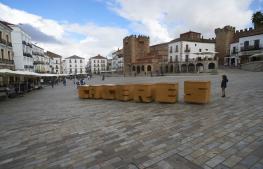
Old Town of Cáceres
The decree declaring Cáceres as a Monumental Site was published on 21 January 1949, and in 1986 UNESCO included the Old Town of Cáceres in its list
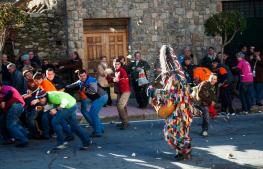
Festivals of Tourist Interest
The province of Cáceres is home to one Festival of International Tourist Interest and two festivals declared as being of National Tourist Interest.

